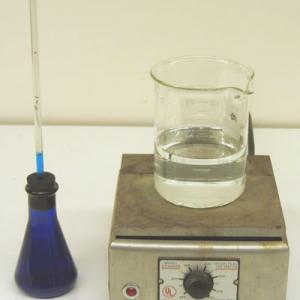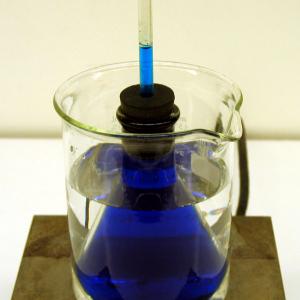College of Liberal Arts & Sciences
4A20.10 - Expansion & Contraction Demo - Liquids
Fill the beaker with colored water and insert the stopper with the glass tube through it. The water level should rise in the glass tube so that you can see it above the stopper. Apply heat and the liquid should expand and rise in the tube. Cool the liquid and the level should go downward in the tube.
The glass air thermometer tubes are filled with colored water. Additional water may have to be added as necessary. Heating the bulb in a water bath will expand the fluid into the tube and the expansion can be calibrated to any temperature scale.
- Shizhuo Luo, Minghui Ma, Zhongping Wang, Lazhen Sun, Zengming Zhang, "Measuring the Expansion Coefficient of Water Using Lloyd's Mirror", TPT, Vol. 62, #4, April 2024, p. 278.
- C. T. Haywood, "Temperature and the Transfer of Heat", TPT, Vol. 14, #6, Sept. 1976, p. 366.
- George M. Hopkins, "Reflection and Concentration of Heat", Experimental Science, p. 192.
- George M. Hopkins, "Air Thermometer", Experimental Science, p. 184.
- A. D. Bulman, "Thermoscopes", Model-Making for Physics, p. 18.
- Charles Vivian, "Expansion Race", Science Experiments & Amusements For Children, p. 81.
- Charles Vivian, "A Simple Thermometer", Science Experiments & Amusements For Children, p. 77.
- Ha- 9: Freier and Anderson, A Demonstration Handbook for Physics.
- Borislaw Bilash II, “A Rather Large Thermometer“, A Demo A Day – A Year of Physical Science Demonstrations, p. 17.
- Borislaw Bilash II, “Heat and Expansion“, A Demo A Day – A Year of Physical Science Demonstrations, p. 73.
- Joseph Frick, "# 347 - Expansion of Liquids", Physical Technics: Or Practical Instructions for Making Experiments in Physics and the Construction of Physical Apparatus with the Most Limmited Means, p. 413.
Disclaimer: These demonstrations are provided only for illustrative use by persons affiliated with The University of Iowa and only under the direction of a trained instructor or physicist. The University of Iowa is not responsible for demonstrations performed by those using their own equipment or who choose to use this reference material for their own purpose. The demonstrations included here are within the public domain and can be found in materials contained in libraries, bookstores, and through electronic sources. Performing all or any portion of any of these demonstrations, with or without revisions not depicted here entails inherent risks. These risks include, without limitation, bodily injury (and possibly death), including risks to health that may be temporary or permanent and that may exacerbate a pre-existing medical condition; and property loss or damage. Anyone performing any part of these demonstrations, even with revisions, knowingly and voluntarily assumes all risks associated with them.


